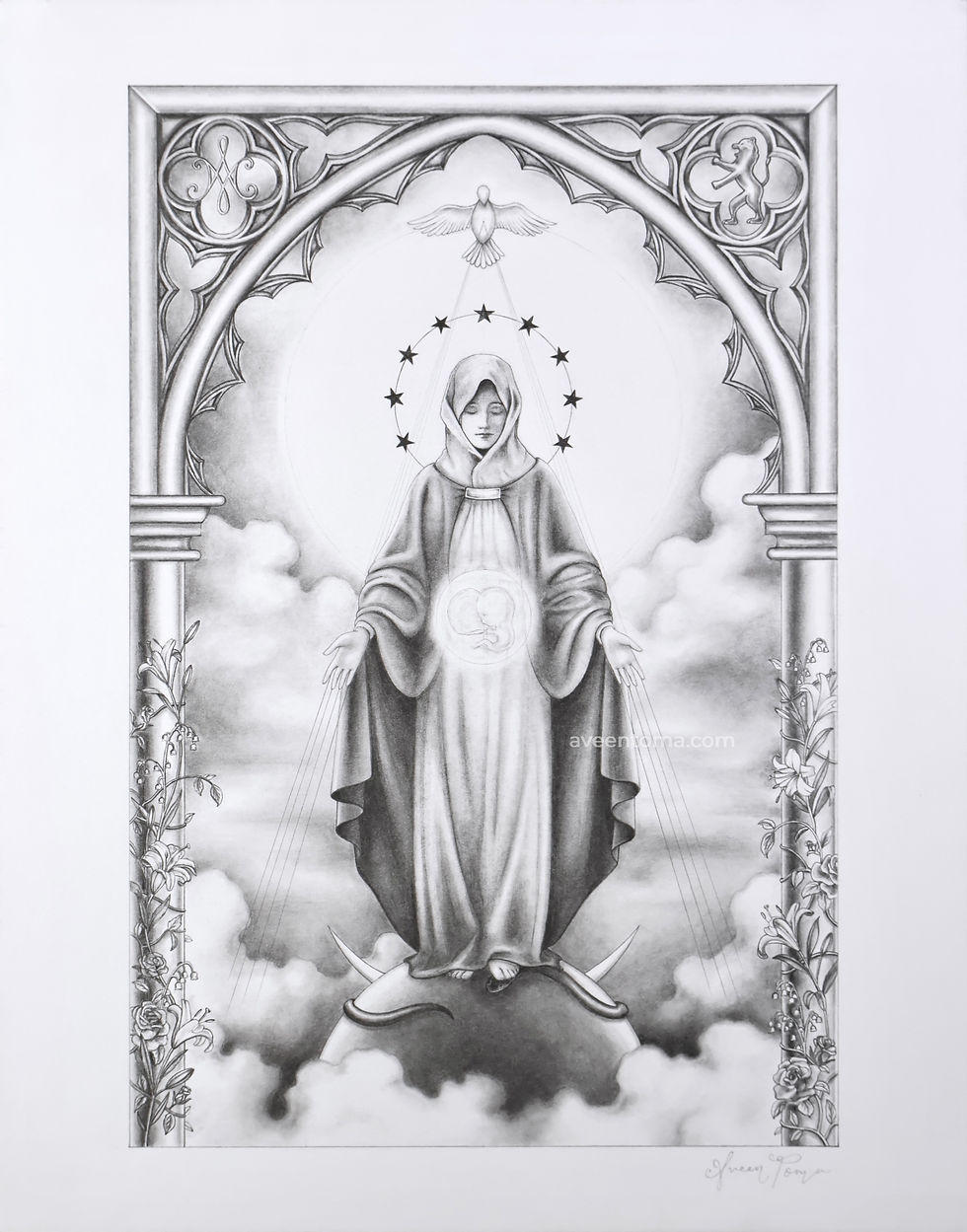Salve Maria Regina
- aveenpetal44
- Sep 12
- 3 min read

graphite on bristol paper · 16 x 20 in · 2025 · commission (prints available here!)
This drawing was commissioned as a wedding gift for a couple, whose wedding was on the Feast of the Queenship of Mary, August 22nd. It is based on and inspired by traditional, black and white intricate lithographs found in the Old Roman Missal.
Mary is illustrated as Queen in the center, flanked by the two confirmation saints and two favorite saints of the couple: St. Albert the Great, St. Mary of Egypt, St. Bonaventure, and St. Thérèse of the Infant Jesus. The names of the four saints are inscribed in Latin around the border, as well as several fitting titles of Mary taken from the Litany of Loreto. The titles read as follows (beginning in the bottom left): Regina Sanctorvm Omnivm (“Queen of All Saints”), Regina in Caelvm Assvmpta (“Queen Assumed into Heaven”), Sancta Maria (“Holy Mary”), Regina Sacratissimi Rosarii (“Queen of the Most Holy Rosary”), and Regina Familiae et Pacis (“Queen of the Family and of Peace”). At the bottom, the invocation, Ora pro nobis (“Pray for us”) is written, directed towards the four saints, as well as recited in response to the titles of Mary, asking them all to pray for the newlywed couple. The text is all handwritten in a traditional medieval Lombardic typeface, commonly used in the Old Missal.
On the central left and right sides of the border are two Marian monograms, or insignias. On the left-hand side is the Auspice Maria (“Under the protection of Mary”) symbol, traditionally depicted as an intertwined A and M. On the right-hand side is the Maria Regina (“Queen Mary”) symbol, illustrated as a single combination of the letters M and R. As is customary to such illustrations, a detailed, intricate border is depicted with geometric designs and stylized flower motifs separating each name and title.
Encircling the composition is a rosary- one of the devotions of the couple. The rosary begins with the Crucifix prominently illustrated right at the center of the entire drawing, showcasing how Christ ought to be the center of our lives, and from Whom all things come and to Whom all things return. This is also seen in how the stance, direction, and facial expressions of each figure are gently tilted towards Him. The Crucifix is also intentionally placed right over the womb of Mary, while at the same time lying safely on her lap and nestled under the protection of her mantle- it is the same place in which the Baby Jesus was conceived and grew, and upon whose lap He sat as a Child. But now, the dead body of her Son is once more placed in her lap- a subtle allusion to the Pietà, when Jesus was taken down from the Cross and given to His mother. The miniature Crucifix dangling from the rosary is once again safely under Mary’s care. At the same time, Our Lady is gently presenting the viewer with the reality and importance of praying the Rosary. Even in the apparitions at Lourdes, Mary prays the doxology of the rosary with Bernadette, which confirms the theocentric nature of the rosary. That theocentric reality is artistically illustrated by having Christ at the center of the composition. Additionally, the first and second Our Father beads, and the three Hail Mary beads, are meticulously placed so as to also serve as an ornamentation on Mary’s mantle and crown. In this way, it is as if the prayers of the Rosary contain, or are part of, Mary herself; this is clearly evident in that the Mysteries of the Rosary are meditations on the life of Christ through Our Lady- just as the rosary chain in this illustration goes through Mary.
As Queen, Mary is depicted with a richly adorned crown and a halo encircled with 12 stars. The number 12 alludes to both the 12 Tribes of Israel and the 12 Apostles, and so it is a traditional motif symbolizing how Mary is the New Israel as well as the Mother of the Church. In this case, it further highlights how she is the Queen of Apostles and Queen of the Church. The background is a starry, heavenly night sky, emphasizing her place of honor as Queen of Heaven. The title of this illustration, Salve Maria Regina (“Hail, Queen Mary”) serves as a salutation to Mary while also alluding to the traditional prayers of the Salve Regina and Ave Maria.













By Aveen Toma · 2025



